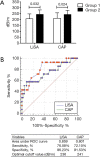Analysis of liver steatosis analysis and controlled attenuation parameter for grading liver steatosis in patients with chronic hepatitis B
- PMID: 33532257
- PMCID: PMC7779909
- DOI: 10.21037/qims-19-1091
Analysis of liver steatosis analysis and controlled attenuation parameter for grading liver steatosis in patients with chronic hepatitis B
Abstract
Background: Chronic hepatitis B is the most common chronic liver disease in China. For patients with chronic hepatitis B, steatosis increases the risk of cirrhosis and hepatocellular carcinoma. This study aimed to analyze and compare the clinical value of a newly developed ultrasound attenuation parameter, liver steatosis analysis (LiSA), acquired by Hepatus (Mindray, China), and controlled attenuation parameter (CAP), a widely used ultrasound attenuation parameter acquired by FibroScan (Echosens, France), for grading liver steatosis in patients with chronic hepatitis B infection.
Methods: A total of 203 patients were divided into two groups according to liver fat content validated by liver biopsy: group 1 (liver fat content <10%) and group 2 (liver fat content ≥10%). All patients underwent LiSA and CAP examinations. Receiver operating characteristic (ROC) curves were calculated for the two ultrasound attenuation tools.
Results: Both LiSA and CAP successfully discriminated between patients in group 1 and group 2. ROC curves showed that both tools had good diagnostic ability (AUC: >0.7) for steatosis ≥10%, and the performance of LiSA was significantly better than CAP (AUC: 0.859 vs. 0.801, P=0.048). Using optimal cut-off points, LiSA had specificity and sensitivity of 96.23% and 76.08%, respectively, for the diagnosis of steatosis ≥10%, compared to 91.53% and 72.10%, respectively, for CAP.
Conclusions: LiSA and CAP are extremely efficient tools for assessing liver steatosis, even at a low grade. Both parameters are non-invasive, inexpensive, and easy to use, and can provide immediate results with high sensitivity.
Keywords: Liver steatosis; chronic hepatitis B; controlled attenuation parameter (CAP); liver steatosis analysis (LiSA); ultrasound attenuation parameter.
2021 Quantitative Imaging in Medicine and Surgery. All rights reserved.
Conflict of interest statement
Conflicts of Interest: All authors have completed the ICMJE uniform disclosure form (available at http://dx.doi.org/10.21037/qims-19-1091). The authors have no conflicts of interest to declare.
Figures


Similar articles
-
A new visual quantitative assessment of ultrasound attenuation parameters for the mild liver steatosis.Ann Transl Med. 2022 Mar;10(6):343. doi: 10.21037/atm-22-989. Ann Transl Med. 2022. PMID: 35433934 Free PMC article.
-
Non-invasive diagnosis of liver steatosis using controlled attenuation parameter (CAP) and transient elastography.Liver Int. 2012 Jul;32(6):911-8. doi: 10.1111/j.1478-3231.2012.02820.x. Liver Int. 2012. PMID: 22672642
-
The diagnostic value of novel ultrasound attenuation analysis in detecting liver steatosis identified by the controlled attenuation parameter: a diagnostic accuracy study.Ann Transl Med. 2023 Jan 31;11(2):38. doi: 10.21037/atm-22-5821. Epub 2023 Jan 9. Ann Transl Med. 2023. PMID: 36819532 Free PMC article.
-
Quantitative assessment of liver steatosis using ultrasound controlled attenuation parameter (Echosens).J Med Ultrason (2001). 2021 Oct;48(4):489-495. doi: 10.1007/s10396-021-01106-1. Epub 2021 Jun 16. J Med Ultrason (2001). 2021. PMID: 34132934 Free PMC article. Review.
-
Magnetic Resonance Imaging-Proton Density Fat Fraction vs. Transient Elastography-Controlled Attenuation Parameter in Diagnosing Non-alcoholic Fatty Liver Disease in Children and Adolescents: A Meta-Analysis of Diagnostic Accuracy.Front Pediatr. 2022 Jan 11;9:784221. doi: 10.3389/fped.2021.784221. eCollection 2021. Front Pediatr. 2022. PMID: 35087774 Free PMC article.
Cited by
-
The association between serum albumin and depression in chronic liver disease may differ by liver histology.BMC Psychiatry. 2022 Jan 4;22(1):5. doi: 10.1186/s12888-021-03647-8. BMC Psychiatry. 2022. PMID: 34983435 Free PMC article.
-
Interplatform Agreement Between Liver Steatosis Analysis and Ultrasound-Guided Attenuation Parameter in the Evaluation of Hepatic Steatosis.J Multidiscip Healthc. 2025 Jul 15;18:4023-4032. doi: 10.2147/JMDH.S528289. eCollection 2025. J Multidiscip Healthc. 2025. PMID: 40687267 Free PMC article.
-
Relationship Between Thyroid Hormone and Liver Steatosis Analysis Parameter in Obese Participants: A Case-Control Study.Diabetes Metab Syndr Obes. 2022 Mar 22;15:887-896. doi: 10.2147/DMSO.S356882. eCollection 2022. Diabetes Metab Syndr Obes. 2022. PMID: 35345544 Free PMC article.
-
Shear wave elastography primer for the abdominal radiologist.Abdom Radiol (NY). 2025 Aug;50(8):3744-3763. doi: 10.1007/s00261-025-04806-1. Epub 2025 Jan 30. Abdom Radiol (NY). 2025. PMID: 39883164 Review.
-
An improved model based on quantitative features of right liver lobe, maximum varices, and portal vein system measured on magnetic resonance imaging to predict oesophagogastric variceal haemorrhage secondary to hepatitis B-related cirrhosis.Quant Imaging Med Surg. 2023 Dec 1;13(12):7741-7752. doi: 10.21037/qims-23-353. Epub 2023 Oct 20. Quant Imaging Med Surg. 2023. PMID: 38106265 Free PMC article.
References
-
- Hu F, Yang R, Huang Z, Wang M, Yuan F, Xia C, Wei Y, Song B. 3D Multi-Echo Dixon technique for simultaneous assessment of liver steatosis and iron overload in patients with chronic liver diseases: a feasibility study. Quant Imaging Med Surg 2019;9:1014-24. 10.21037/qims.2019.05.20 - DOI - PMC - PubMed
-
- Machado MV, Oliveira AG, Cortez-Pinto H. Hepatic steatosis in hepatitis B virus infected patients: meta-analysis of risk factors and comparison with hepatitis C infected patients. J Gastroenterol Hepatol 2011;26:1361-7. - PubMed
LinkOut - more resources
Full Text Sources
Other Literature Sources
Miscellaneous
